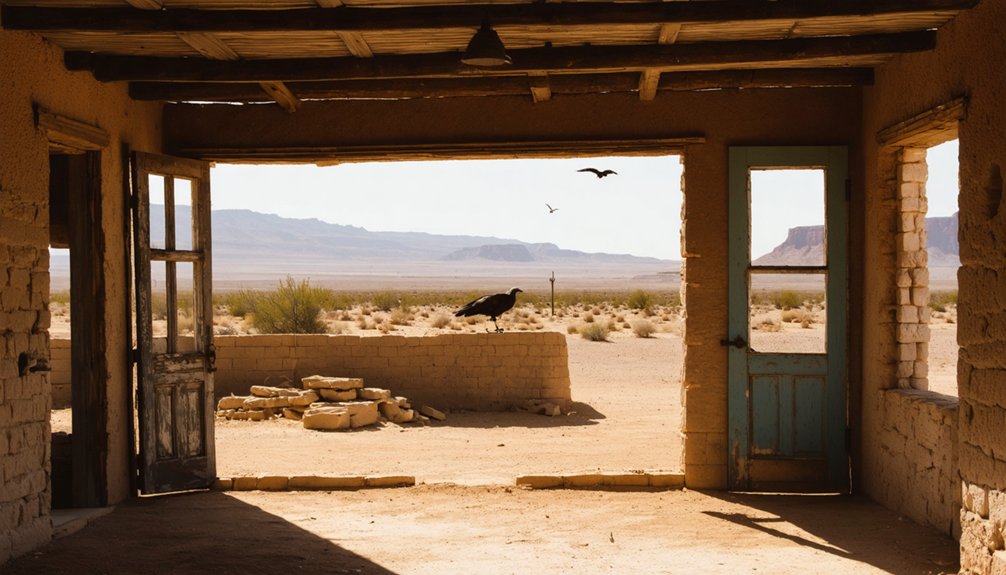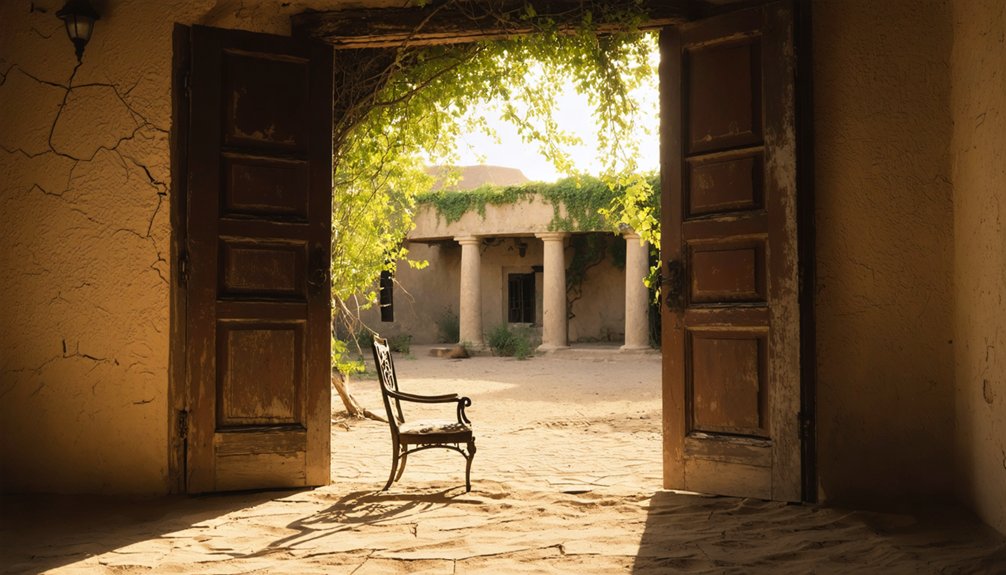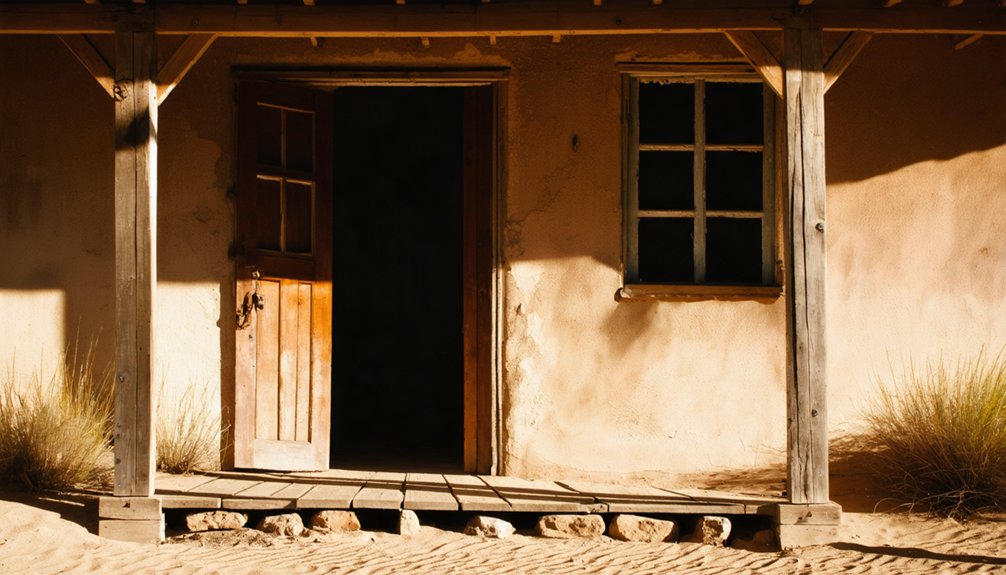You’ll find Ojo de Veranda in West Texas’s Presidio County, where natural springs first attracted Native American settlements and later drew European settlers in 1876. The springs became vital for this desert community’s survival, supporting local ranching and trade between Mexico and Texas. While harsh desert conditions eventually led to the town’s abandonment, you can still spot scattered stone foundations and chimneys among the desert landscape, each telling a story of this once-thriving settlement.
Key Takeaways
- Established in 1876 around natural desert springs, Ojo de Veranda served as a vital trade and ranching hub in West Texas.
- The town’s survival depended on its springs, which attracted Native Americans, settlers, and travelers crossing the Chihuahuan Desert.
- Stone foundations and chimneys are all that remain of the once-thriving community, now reclaimed by the desert environment.
- The settlement’s decline was driven by dwindling resources and harsh desert conditions, leading to its eventual abandonment.
- The ghost town site showcases the region’s history through its ruins while supporting native desert wildlife and plant species.
The Origins of a Desert Settlement
Before Spanish settlers arrived in what would become Ojo de Veranda, Native American tribes had long recognized the site’s essential water sources, establishing seasonal camps around its reliable desert springs.
You’ll find evidence of their presence in artifacts scattered across this arid landscape, where they’d gathered for generations before European contact.
The first major settlement challenge came in 1810 when Eugenio Gutiérrez received a Spanish land grant for the area.
Despite the springs’ appeal, indigenous resistance forced him to abandon his settlement attempts.
His son Isidro faced similar obstacles in 1835, retreating in the face of determined Native American opposition.
The Texas Rangers camped here in 1850, working to protect traders traveling between Laredo and Corpus Christi.
Much like the safe river crossing at Plemons that drew early settlers, these springs became a crucial stopping point for travelers.
The pattern of settlement challenges continued until the Guerra brothers, Dionicio and José María, rediscovered their grandfather’s springs, following cattle tracks that led them to these precious water sources.
Life Around the Natural Springs
The discovery of natural springs by the Guerra brothers marked a turning point in Ojo de Veranda’s development, transforming the site from contested territory into a thriving desert community.
You’d find spring water sustaining daily life, from cooking to washing, while creating a crucial hub for community gatherings and trade. The springs formed an oasis in the harsh landscape, attracting both settlers and indigenous peoples who established camps nearby. Like the many immigrant coal miners who flocked to Thurber, these settlers sought opportunities in this promising new territory. Similar to how sulfur deposits drew people to New Gulf, the natural springs attracted pioneers looking to build a new life.
- Springs created microhabitats supporting native plants and wildlife, providing food and medicine for inhabitants.
- Spring locations served as fundamental waypoints for travelers crossing eastern Presidio County.
- Daily activities centered around these water sources, where residents would converge to socialize and trade.
The springs’ reliable water enabled small-scale agriculture and livestock operations, making sustained settlement possible in this unforgiving desert environment.
Geographic Significance in Early Texas
While many Texas settlements emerged near rivers and lakes, Ojo de Veranda‘s strategic position in eastern Presidio County centered on its rare desert springs.
Similar to how quicksilver mining operations drove Terlingua’s growth in the early 1900s, Ojo de Veranda’s reliable water source made it a crucial stopping point in the harsh Chihuahuan Desert landscape.
The town’s geographic trade significance became evident by 1876, as it served travelers and ranchers moving between Mexico and other parts of Texas.
Settlement patterns developed around the springs, creating a self-sufficient community despite the challenging terrain.
You can trace how the surrounding mountains and arid environment shaped the town’s development, forcing adaptation to ranching rather than farming.
This remote outpost’s springs proved essential for indigenous peoples, Spanish settlers, and Mexican ranchers alike.
Like the historic General Store in Turling, local gathering spots became vital hubs for community life and information sharing.
The Mystery of Daily Life
When you picture daily life in Ojo de Veranda, you’ll find that water from the town’s spring played the most essential role in sustaining the community.
You’d see families congregating near this important water source, using it not just for drinking but also for their modest agricultural efforts and livestock.
Your understanding of frontier survival deepens when you consider how these resourceful families adapted to the harsh environment, developing water conservation techniques and cooperative sharing systems that kept their isolated community alive. Much like the residents of Terlingua’s mining village, the community worked together to overcome the challenges of their remote location.
Just as historical preservation efforts today help maintain records of such frontier communities, the townspeople of Ojo de Veranda worked diligently to preserve their water resources for future generations.
Water’s Life-Giving Role
Life-sustaining springs transformed Los Ojuelos into a rare oasis amid South Texas’s harsh desert landscape, where Native Americans and early settlers relied on these precious water sources for survival.
In the face of water scarcity, you’d find residents meticulously mapping spring locations and tracking animal signs to locate these essential resources. Spring preservation became significant as these water sources anchored the town’s development into a thriving market and ranching center. Much like in Shafter, the presence of nearby water sources allowed trees to flourish in an otherwise arid environment.
- Springs determined settlement patterns and security, often leading to conflicts over control
- Water enabled fundamental daily activities from cooking to livestock management
- Sacred water sites attracted both indigenous ceremonies and trading activities
The town’s fate ultimately hinged on these water sources – when they diminished or lost utility, residents departed, leaving behind another Texas ghost town.
Frontier Family Survival
Beyond the precious water sources that shaped Los Ojuelos, the daily rhythms of frontier family life revealed remarkable adaptations to harsh conditions.
You’d find clear family roles emerged: boys hunted and worked fields alongside their fathers, while women mastered essential survival skills from marksmanship to preserving meat.
Children gathered fuel – buffalo chips, cattle dung, and cornstalks – when wood grew scarce.
At home, you’d need to be resourceful, as women managed households without mechanical aids while often running small businesses.
Great Plains blizzards could trap families indoors for days, requiring careful stockpiling of supplies and fuel.
As isolation tested settlers’ resolve, they’d gather for quilting bees, religious services, and community dances.
Through these shared hardships and celebrations, frontier families forged bonds that helped them persevere in Texas’s unforgiving landscape.
A Town Lost to Time

Deep in eastern Presidio County, Ojo de Veranda stands as a tribute to the fleeting nature of frontier settlements.
By 1876, this now-vanished town emerged near San Esteban, south of present-day Marfa, where cultural influences from both sides of the border shaped daily life.
You won’t find it on modern maps, as economic shifts and changing times have erased its physical presence.
- The town’s name, suggesting a connection to local springs, hints at the critical role water played in its establishment.
- Like many frontier settlements, Ojo de Veranda fell victim to the harsh realities of desert life and dwindling resources.
- While no visible structures remain, historical records preserve the town’s legacy in Texas’ pioneering history.
Your journey through this ghost town’s past reveals the delicate balance between human ambition and nature’s constraints.
The Legacy in West Texas History
Though it vanished from modern maps, Ojo de Veranda left an indelible mark on West Texas history as an important trade and ranching hub.
You’ll find its roots stretching back to 1876, when settlers established the town near San Esteban, drawn by the area’s reliable springs that had attracted Native Americans for centuries before.
The town’s cultural heritage reflects the complex blend of Spanish, Mexican, and Anglo influences through families like the Gutiérrez and Guerra.
You can trace its economic activity through the late 19th century, when it served as an essential center for ranching and commerce.
The settlement’s strategic location near water sources made it important for survival in the harsh West Texas environment, while its story exemplifies the resilience of frontier life and the boom-and-bust cycles that shaped the region.
Traces in the Desert Landscape

You’ll find only scattered stone foundations and chimneys marking where Ojo de Veranda once stood in the eastern Presidio County desert.
The town’s original springs, which drew settlers in the late 1800s, shaped the placement of buildings whose remnants now lie partially buried beneath shifting sands and desert vegetation.
Time and harsh desert conditions have steadily eroded the site, leaving just fragments of metal, ceramics, and building materials to tell the story of this forgotten settlement.
Springs Shaped Settlement History
In the arid landscape of Webb County, Texas, natural springs played a pivotal role in shaping early settlements like Los Ojuelos. The spring significance extended far beyond mere survival, as these water sources became focal points for historical trade and community development.
You’ll find these springs were instrumental in attracting both Native American camps and European settlers, leading to the establishment of thriving market towns.
- Springs determined the location of essential river crossings and trade routes
- Native Americans and settlers often competed for control of these crucial water sources
- Early maps marked these springs to guide travelers and future settlement efforts
When you explore these historic sites today, you’re witnessing the remnants of communities that rose and fell based on their relationship with these life-giving water sources.
Desert’s Mark Remains Today
While the springs shaped early settlement patterns, the desert environment has left its own lasting imprint on Ojo de Veranda.
You’ll find unique geological formations sculpted by wind and sand, showcasing the land’s natural resilience through time. Hardy desert plants have adapted to the harsh conditions, demonstrating remarkable desert adaptation alongside wildlife like coyotes, jackrabbits, and rattlesnakes that still roam the area.
The landscape continues to evolve through erosion patterns, and you can spot potential mineral deposits throughout Presidio County’s terrain.
Today, these natural elements persist even as the town’s physical structures have vanished. When you explore the site, you’re witnessing a dynamic ecosystem where the desert’s raw beauty has reclaimed what humans once built, creating an ever-changing monument to nature’s persistence.
Frequently Asked Questions
Were There Any Notable Conflicts or Raids in Ojo De Veranda?
You won’t find a specific conflict timeline or raid impacts documented for this settlement, though the region experienced Mexican-American tensions and bandit activity during the late 1800s.
What Type of Buildings or Structures Were Originally Built in the Town?
You’d have found basic adobe residential buildings and simple commercial structures built in the late 1800s, including ranch homes, trading posts, and likely a small church or mission.
Did Any Famous Historical Figures Ever Visit Ojo De Veranda?
You won’t find records of any famous visitors in this remote settlement. The town’s limited historical significance and sparse documentation suggest prominent figures didn’t make their way to this frontier outpost.
What Happened to the Natural Springs That Once Supplied the Town?
You’ll find no definitive records of what happened to the springs. Like many natural resources in the region, they likely dried up due to water scarcity and changing environmental conditions.
Were There Any Schools or Churches Established in Ojo De Veranda?
You won’t find any church history or school legacy in this settlement – historical records show no evidence of either being established during the town’s brief existence in the late 1800s.
References
- https://www.thestoryoftexas.com/discover/texas-story-project/los-ojuelos-webb-co
- https://mix941kmxj.com/the-strange-sad-story-of-a-texas-ghost-town-youll-never-visit/
- https://www.hipcamp.com/journal/camping/texas-ghost-towns/
- https://www.southernthing.com/ruins-in-texas-2640914879.html
- https://discovertexasoutdoors.com/places/ojo-de-veranda/
- https://www.tshaonline.org/handbook/online/articles/hvo51
- https://texashighways.com/travel-news/four-texas-ghost-towns/
- https://www.youtube.com/watch?v=phjUE19A8HM
- https://en.wikipedia.org/wiki/List_of_ghost_towns_in_Texas
- https://www.texasalmanac.com/places/ojo-de-agua



